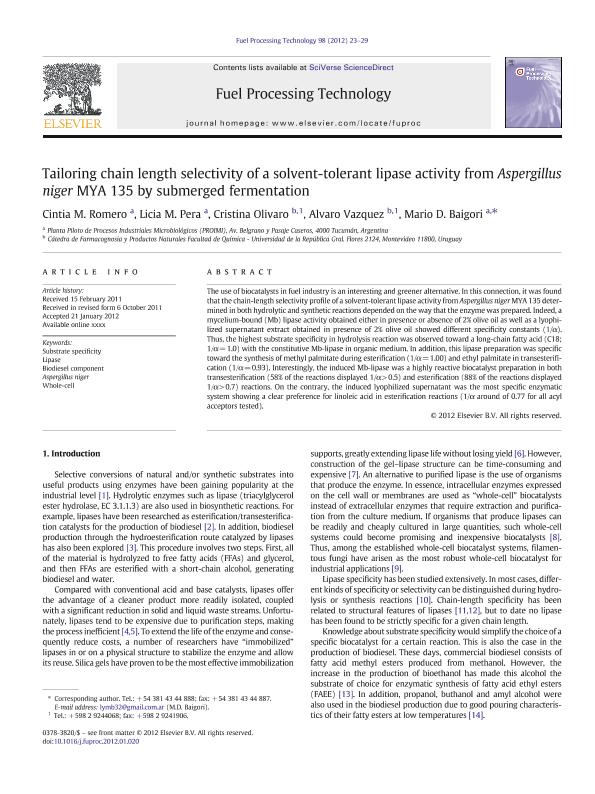Mostrar el registro sencillo del ítem
dc.contributor.author
Romero, Cintia Mariana

dc.contributor.author
Pera, Licia Maria

dc.contributor.author
Olivaro, Cristina
dc.contributor.author
Vazquez, Alvaro
dc.contributor.author
Baigori, Mario Domingo

dc.date.available
2018-03-02T19:14:54Z
dc.date.issued
2012-06
dc.identifier.citation
Romero, Cintia Mariana; Pera, Licia Maria; Olivaro, Cristina; Vazquez, Alvaro; Baigori, Mario Domingo; Tailoring chain length selectivity of a solvent-tolerant lipase activity from Aspergillus niger MYA 135 by submerged fermentation; Elsevier Science; Fuel Processing Technology; 98; 6-2012; 23-29
dc.identifier.issn
0378-3820
dc.identifier.uri
http://hdl.handle.net/11336/37695
dc.description.abstract
The use of biocatalysts in fuel industry is an interesting and greener alternative. In this connection, it was found that the chain-length selectivity profile of a solvent-tolerant lipase activity from Aspergillus niger MYA 135 determined in both hydrolytic and synthetic reactions depended on the way that the enzyme was prepared. Indeed, a mycelium-bound (Mb) lipase activity obtained either in presence or absence of 2% olive oil as well as a lyophilized supernatant extract obtained in presence of 2% olive oil showed different specificity constants (1/α). Thus, the highest substrate specificity in hydrolysis reaction was observed toward a long-chain fatty acid (C18; 1/α = 1.0) with the constitutive Mb-lipase in organic medium. In addition, this lipase preparation was specific toward the synthesis of methyl palmitate during esterification (1/α = 1.00) and ethyl palmitate in transesterification (1/α = 0.93). Interestingly, the induced Mb-lipase was a highly reactive biocatalyst preparation in both transesterification (58% of the reactions displayed 1/α > 0.5) and esterification (88% of the reactions displayed 1/α > 0.7) reactions. On the contrary, the induced lyophilized supernatant was the most specific enzymatic system showing a clear preference for linoleic acid in esterification reactions (1/α around of 0.77 for all acyl acceptors tested).
dc.format
application/pdf
dc.language.iso
eng
dc.publisher
Elsevier Science

dc.rights
info:eu-repo/semantics/openAccess
dc.rights.uri
https://creativecommons.org/licenses/by-nc-nd/2.5/ar/
dc.subject
Aspergillus Niger
dc.subject
Biodiesel Component
dc.subject
Lipase
dc.subject
Substrate Specificity
dc.subject
Whole-Cell
dc.subject.classification
Biotecnología Industrial

dc.subject.classification
Biotecnología Industrial

dc.subject.classification
INGENIERÍAS Y TECNOLOGÍAS

dc.title
Tailoring chain length selectivity of a solvent-tolerant lipase activity from Aspergillus niger MYA 135 by submerged fermentation
dc.type
info:eu-repo/semantics/article
dc.type
info:ar-repo/semantics/artículo
dc.type
info:eu-repo/semantics/publishedVersion
dc.date.updated
2018-03-02T14:57:33Z
dc.journal.volume
98
dc.journal.pagination
23-29
dc.journal.pais
Países Bajos

dc.journal.ciudad
Amsterdam
dc.description.fil
Fil: Romero, Cintia Mariana. Consejo Nacional de Investigaciones Científicas y Técnicas. Centro Científico Tecnológico Conicet - Tucuman. Planta Piloto de Procesos Industriales Microbiologicos; Argentina
dc.description.fil
Fil: Pera, Licia Maria. Consejo Nacional de Investigaciones Científicas y Técnicas. Centro Científico Tecnológico Conicet - Tucuman. Planta Piloto de Procesos Industriales Microbiologicos; Argentina
dc.description.fil
Fil: Olivaro, Cristina. Universidad de la República; Uruguay
dc.description.fil
Fil: Vazquez, Alvaro. Universidad de la República; Uruguay
dc.description.fil
Fil: Baigori, Mario Domingo. Consejo Nacional de Investigaciones Científicas y Técnicas. Centro Científico Tecnológico Conicet - Tucuman. Planta Piloto de Procesos Industriales Microbiologicos; Argentina
dc.journal.title
Fuel Processing Technology

dc.relation.alternativeid
info:eu-repo/semantics/altIdentifier/doi/http://dx.doi.org/10.1016/j.fuproc.2012.01.020
dc.relation.alternativeid
info:eu-repo/semantics/altIdentifier/url/https://www.sciencedirect.com/science/article/pii/S0378382012000379
Archivos asociados
